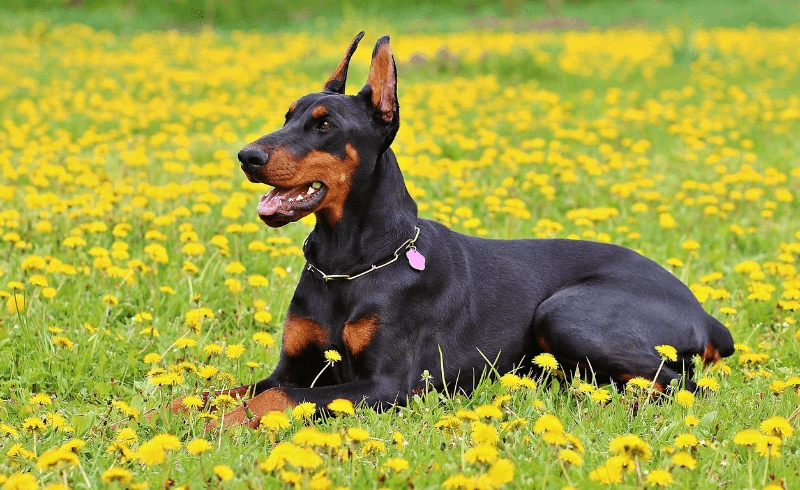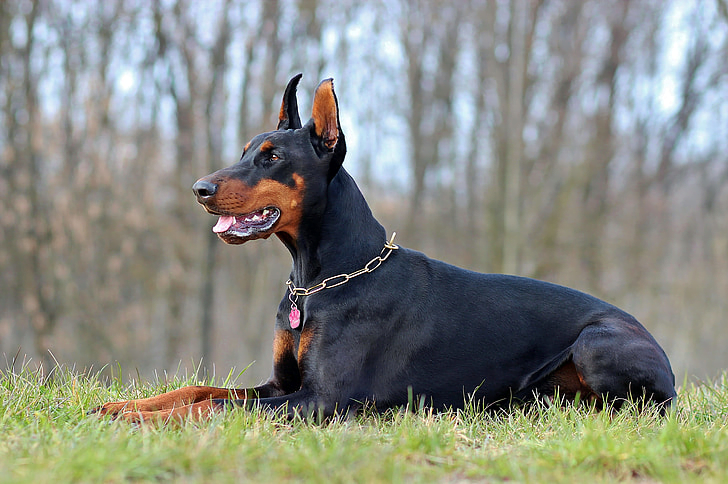The Dobermann, a breed known for its loyalty and intelligence, stands as a paragon of canine excellence. Originating in the late 19th century, these dogs have carved their niche not only as fearless protectors but also as beloved family members. Their sleek coat, athletic build, and sharp wit make them highly sought after for various roles, including police work, search and rescue operations, and as companion animals. This blog post aims to delve into the rich history, characteristics, and care requirements of the Dobermann breed. By providing a comprehensive overview, we hope to enlighten potential owners and enthusiasts about what makes these dogs truly remarkable.
Key Takeaways
- Dobermanns are a loyal and intelligent breed, making them excellent family pets and protectors.
- Regular health check-ups and a proper diet are crucial for maintaining a Dobermann’s health, as they are prone to certain genetic conditions.
- It’s important to provide Dobermanns with enough physical exercise and mental stimulation to keep them happy and prevent destructive behavior.
- When considering adding a Dobermann to your family, seek reputable breeders or adoption centers that can provide health clearances for the dog’s parents.
- Training and socialization from a young age are essential for Dobermanns to ensure they grow up to be well-behaved and sociable dogs.
- Dobermanns thrive in environments where they can be close to their human families, showcasing their loyalty and affectionate nature.
Breed Overview
History
The Dobermann breed traces its origins to Germany, where Karl Friedrich Louis Dobermann, a tax collector, developed the breed in the late 19th century. He sought a loyal and protective companion for personal protection during his collections. The breed quickly evolved from a personal guardian to a versatile working dog, demonstrating exceptional abilities in various roles.
Dobermanns have served with distinction in military and police work throughout history. Their intelligence and courage made them invaluable in both World Wars. This service has cemented their reputation as one of the most reliable working breeds.
Physical Characteristics
Dobermanns boast a sleek, muscular build that epitomizes strength and agility. Males typically stand between 26 to 28 inches tall at the shoulder, while females are slightly smaller, measuring 24 to 26 inches. Their size contributes to their imposing presence but is balanced by their elegant appearance.
The breed exhibits distinctive color patterns: primarily black, red, blue, and fawn with rust markings above the eyes, on the muzzle, chest, legs, and beneath the tail. These colors enhance their striking appearance. Physical features such as the docked tail and cropped ears are traditional but vary by country due to differing animal welfare laws.
Personality and Temperament
Dobermanns are known for their unwavering loyalty and protective nature towards their family. This devotion makes them excellent companions. Contrary to common misconceptions about aggression, they are friendly and trainable dogs when properly socialized. They thrive on human interaction and are eager to please.
Their intelligence and high energy levels make them well-suited for active families or individuals who can provide them with physical exercise and mental stimulation. Training them is usually rewarding because of their quick learning ability. However, potential owners should note that Dobermanns require consistent leadership to channel their energy positively.
![]()
Health And Care
Common Health Issues
Dobermanns are prone to several genetic health concerns. Key issues include dilated cardiomyopathy (DCM), von Willebrand’s disease, and hip dysplasia. These conditions can affect their quality of life significantly. Therefore, owners must prioritize regular health screenings. These should focus on the heart, thyroid, and joints to catch any problems early.
The breed typically enjoys a lifespan of 10-13 years. With proper care, this duration can reflect a healthy and fulfilling life for the dog.
Dietary Needs
A balanced diet is crucial for Dobermanns. It should match their age, size, and activity level to ensure they get all necessary nutrients. High-quality protein sources are vital for maintaining their muscle mass. This helps them stay strong and active.
However, owners must be cautious about overfeeding. Excess weight can lead to obesity and associated health issues like joint stress and heart problems.
Exercise Requirements
Due to their high energy levels, Dobermanns require regular, vigorous exercise. Activities such as running, agility training, and obedience competitions are excellent ways to keep them fit and mentally stimulated.
Besides physical activities, mental stimulation is also essential. It prevents boredom and destructive behavior. Owners should find creative ways to engage their Dobermann’s mind daily.
Grooming
The Dobermann’s coat is low-maintenance but still needs attention. Regular brushing helps reduce shedding and keeps the coat shiny.
Routine nail trimming, ear cleaning, and dental care are also important parts of a grooming routine. They contribute to the overall health of the dog by preventing common issues like infections or dental diseases.
Living with a Dobermann
Training and Socialization
Early socialization is vital for a Dobermann. It helps prevent aggression and shyness as they grow. Introducing them to different people, animals, and environments when they are young is key. This variety helps them become well-adjusted adults.
Positive reinforcement techniques work best for training Dobermanns. Use treats, praise, and play to encourage good behavior. They respond well to rewards because of their eagerness to please.
Consistency and patience are crucial. Despite their intelligence, Dobermanns can be stubborn. Regular, short training sessions keep their minds active and reduce boredom. Always be patient and persistent with them.
Environment
Dobermanns adapt well to different living situations, including apartments. However, they need sufficient exercise to stay happy in smaller spaces. Daily walks and playtime are essential for their physical and mental health.
Leaving them alone for long periods can lead to anxiety and destructive behavior. They thrive on companionship and being part of family activities.
A secure, fenced area is important for outdoor play. It prevents wandering and ensures safety during off-leash time.
Activities They Enjoy
Dobermanns enjoy a variety of activities that engage both their bodies and minds. Interactive games like fetch or tug-of-war stimulate them physically and mentally.
They excel in dog sports such as agility and rally obedience due to their high intelligence and agility. These activities provide great physical exercise and mental stimulation.
Companionship activities like hiking or jogging with their owners bring them joy. They love spending time with their families while exploring new environments.

Breeder Advice and Adoption
Choosing a Breeder
When looking to welcome a Dobermann into your home, finding the right breeder is crucial. It’s important to research reputable breeders who prioritize the health and well-being of their dogs. These breeders conduct thorough health screenings and provide clearances for genetic conditions common in Dobermanns.
Before making a decision, ask for references from past buyers. This step can give you insight into the breeder’s practices and the quality of life of the puppies. Visiting the breeding facility is essential. Observing the conditions firsthand allows you to see how the dogs are raised and cared for.
Meeting the puppy’s parents offers valuable information about what to expect in terms of temperament and health. It’s often said that looking at a puppy’s parents can offer a glimpse into the future. This visit also allows you to interact with the breed firsthand, ensuring it’s a good fit for your lifestyle, especially if living with a Dobermann is new to you.
Adoption
Adoption is another heartfelt way to bring a Dobermann into your life. Many Dobermann rescues and shelters have dogs waiting for their forever homes. When considering adoption, it’s vital to assess an adoptable dog’s temperament and health status. This ensures they’re a good match for your home environment.
Adopting an adult dog comes with its set of benefits. One significant advantage is bypassing the demanding puppy stage. Adult dogs often come with basic training and are usually less destructive than puppies. This can be particularly appealing if you’re not prepared for the intense energy levels and training needs of a young Dobermann.
Benefits of adopting include giving a second chance to a dog in need. It also means potentially avoiding some genetic health issues by selecting an adult whose health history is known or can be assessed more accurately than that of a puppy.
Misc.
Popular Names
Choosing the right name for a Dobermann is more than just picking something that sounds good. It’s about finding a name that mirrors their bold personality and impressive physique. Common names like Max, Bella, Zeus, and Athena are popular among Dobermann owners. These names not only reflect the dog’s strong characteristics but also add to their commanding presence.
It’s crucial to pick a name that fits your dog’s unique traits. A powerful name like Zeus might suit a male Dobermann with a protective nature, while Athena could be perfect for an intelligent and alert female. The importance of a name extends beyond just identification; it plays a significant role in training and bonding. A well-chosen name can enhance your connection with your Dobermann, making commands clearer and strengthening your relationship.
Top Dog Grooming Tools (Click Here)
Fun Facts
The Dobermann holds the unique distinction of being the only dog breed named after its founder, Karl Friedrich Louis Dobermann. This fact alone places the breed in a special category, highlighting its unique origin. Besides their distinguished beginnings, Dobermanns have served valiantly as war dogs during WWII. Their courage and versatility on the battlefield demonstrate their loyalty and bravery, traits revered by dog lovers worldwide.
In pop culture, Dobermanns have made their mark as well. Notably, Zeus and Apollo from the TV show “Magnum, P.I.” showcased the breed’s protective instincts and intelligence. These famous Dobermanns have contributed to the breed’s popularity and public image, illustrating their ability to be both fierce protectors and loyal companions.
Final Remarks
The Dobermann, with its distinguished look and loyal temperament, stands as a testament to the breed’s versatility and adaptability in various roles, from family companion to protector. This article has traversed through the essential aspects of their care, health, living conditions, and the importance of sourcing from reputable breeders or considering adoption. Their well-being hinges on informed ownership, emphasizing regular health checks, proper training, and understanding their unique needs.
For those contemplating bringing a Dobermann into their lives, it becomes crucial to weigh the responsibilities that accompany such a decision. It is not just about providing a home but also about fostering an environment where they can thrive physically and emotionally. The journey with a Dobermann is one of mutual respect and understanding. Interested individuals should seek further information and connect with experienced owners or breed clubs to ensure they are well-prepared for this rewarding commitment.
Frequently Asked Questions
What is the average lifespan of a Dobermann?
Dobermanns typically live between 10 to 13 years. Proper care and regular veterinary check-ups can help ensure they live a full, healthy life.
How much exercise does a Dobermann need?
A Dobermann requires at least one hour of exercise daily. This breed thrives on physical activity and mental stimulation to stay healthy and happy.
Are Dobermanns suitable for families with children?
Yes, Dobermanns can be great family pets when properly trained and socialized. They are known to be loyal, protective, and affectionate towards their family members, including children.
What health issues are common in Dobermanns?
Common health issues in Dobermanns include dilated cardiomyopathy (DCM), von Willebrand’s disease, hip dysplasia, and hypothyroidism. Regular health screenings can help detect these conditions early.
How do I find a reputable Dobermann breeder?
Look for breeders who perform health tests on their breeding dogs, are registered with recognized kennel clubs, provide detailed health information about the puppies’ parents, and offer ongoing support after adoption.
Can Dobermanns adapt to living in an apartment?
While Dobermanns can adapt to apartment living, they require sufficient daily exercise and mental stimulation. Without it, they may develop behavioral issues due to their high energy levels.
What is the best way to train a Dobermann?
Positive reinforcement techniques work best for training Dobermanns. They respond well to rewards-based training that includes treats, praise, and playtime for good behavior. Consistency and patience are key.






0 Comments